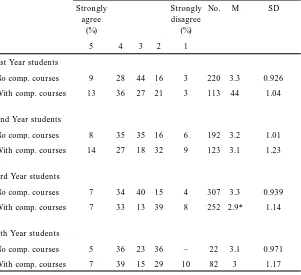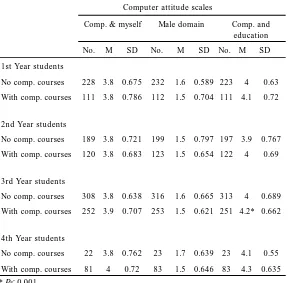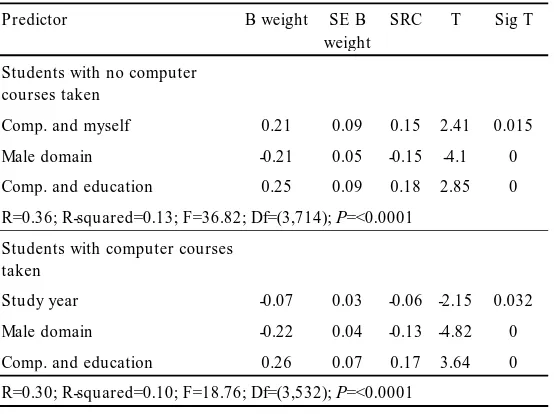Perceived Relevance of Information
Technology Courses to Prospective Teachers’
Professional Needs: the case of Greece
VASILIOS MAKRAKIS University of Crete, Greece
ABSTRACT This study was designed to assess the extent to which computer courses provided by teacher education institutions in Greece fulfilled the professional needs of their students. A non-probability accidental sample of 1407 student teachers responded to a questionnaire. The analysis of collected data included t-tests and multiple regressions. The results of this study suggest that students are not convinced that the computer courses offered at their departments match their professional needs as teachers.
Information Technology in the Greek Education System
During the late 1980s government officials and education experts became increasingly convinced that exposure to computer literacy or informatics should become an integral part of modern education. In response to the challenge of incorporating computers in school education, the Greek Ministry of Education introduced computer literacy as an independent compulsory course at the second grade of integrated lyceums in 1985. Apart from integrated lyceums, the government also decided to implement computer literacy in all lower secondary general schools. Current experiences show that the introduction and implementation of “informatics” in the Greek schools, as an independent compulsory course, reflects a picture of nothing more than isolated theoretical and technocentric components of computer literacy instruction (Kontogiannopoulou-Polydorides & Kynigos, 1993; Maritsas, 1993; Makrakis & Kontogiannopoulou- Polydorides,1995).
behind among the European participants in this study, in terms of the aim and content of teaching provided by “informatics” in school education (Plomp & Pelgrum, 1991). In the five European countries which participated in the IEA Computer Study, the emphasis on the content of information technology was mostly a mixture of an independent course and tool-based educational use of computer technology. Contrary to that, the kinds of applications used in the case of Greece were strongly directed towards programming languages followed by word processors and data bases.
Recently, there has been an effort by individual teachers to change this picture. The Ministry of Education has also started to re-examine its policy and provided a new syllabus for informatics in school education. However, all these efforts are inhibited by the lack of appropriately trained informatics teachers. The “informatics” course is taught by mathematics or physics teachers, with minimal pedagogical and educational computing education. The recent pressure to include graduates from Computer Science departments as teachers of informatics in schools may provide another obstacle for the pedagogical use of new technologies in schools. This pressure is largely exerted by the low absorption of computer science graduates in the labour market. Teacher training has been largely carried out by teacher professional associations, especially the Greek Society of Mathematics, the Union of Greek Physicists, the Society of Computer Programmers and the various training courses offered through the scheme of European Union Policy on training.
In the last five years, the departments of primary education have taken the first steps to introduce computer courses in their study programmes. This became more urgent in light of the new plans to extend the introduction of computers in primary schools in Greece. Indeed, teacher education institutions of primary school level in Greece have been pioneering in introducing informatics into their curricula. However, no research evidence exists as to the extent to which the courses offered in this field fulfil the expectations and professional needs of their students.
Theoretical Framework
Can we say, however, that today’s teacher education programmes are preparing prospective teachers to successfully incorporate computers into their teaching? Surveys show that opportunities for preservice teachers to use information technology effectively are very limited in their courses, especially in the areas related to the implementation of the National Curriculum (Wild & Hodgkinson, 1992; Handler, 1993; Harrington, 1993). Handler and Marshall (1992) found that less than 20% of beginning teachers surveyed felt prepared to use information technology in their teaching, whilst a smaller minority actually used computers in their classrooms. Oliver (1994) found that 75% of West Australian beginning teachers did not make use of computers for instructional purposes, in spite of good access to hardware and software. In a more recent study (Wild, 1995), 83% among those who completed an information technology course did not make any use of information technology in their teaching practice and 91% did not make use of information technology for personal work (e.g. teacher preparation). In attributing reasons for their non-use of information technology, students highlighted the following factors:
x insufficient access to suitable software;
x lack of knowledge about classroom use of IT; and
x lack of confidence in using computers in the classroom.
As pointed out earlier, there have been many attempts to include informatics in pre-service teacher education in Greece so that future teachers will be able to contribute effectively to pedagogical innovation and change, as well as to respond to the information technology requirements of their pupils. The purpose of this study was therefore to assess the perceived relevance of computer courses offered in primary teacher education institutions in Greece to student–teachers’ professional needs. The preparation of the Greek teacher education institutions to meet current and future new information technology needs is assessed in the light of a survey of student–teachers, substantiated by the collection of data on the syllabi of computer courses. The main research questions were:
x Do computer courses meet the professional needs of prospective teachers?
x Are there any differences in attitudes towards computers in education based on student gender, and previous computer experience?
x Are there differences in perceptions regarding the match of student-teachers’ education on computers and their future teaching need with:
– student gender; – study year;
Methodological Framework
Subjects
The study included data on 1407 student teachers (24% male, 76% female) from seven out of eight university departments of primary teacher education in Greece. The data for this study were collected during the 1991/ 92 academic year. This was an accidental non-probability based sample, since the formation of a strictly probability-based sample was impossible, mainly due to the low rate of course attendance. Despite this limitation, the sample which corresponds to about 25% of the total population could be considered representative as it reflects the great majority of those who regularly attend courses.
Design and Procedure
The main instrument for data collection was a questionnaire containing background information and a number of attitudinal statements. The dependent variable in the study was the perceived relevance of information technology courses to students’ professional preparation. The independent variables were gender, study year, the number of information technology courses taken, and information technology attitudes. The three attitude dimensions investigated in this study, with the number of items included in the scale in parentheses, were Computers and Myself (n=4), Computers as a Male Domain (n=3), and Computers and Education (n=3). All the attitude items were presented in a Likert-type scale, with five response options ranging from 1 (low level attitude) to 5 (high level attitude). The extent to which students enjoy studying computers, feel confident in their ability as learners of computers, and want to participate in computer courses are reflected in the Computers and Myself scale. The Computers as a Male Domain scale examined the extent to which computers were gender-typed in favour of males. A higher rating indicated the presence of stereotyping computers as a domain more appropriate for males than for females. The Computers and Education scale was designed to measure students’ views of the usefulness and importance of computers to teacher education. A positive view indicated that educational computing was seen as useful in education and important in preparing for a teaching profession.
Separate reliabilities for the three composite attitude variables were calculated. Estimates of the internal consistency based on Cronbach’s alpha were as follows:
x Computers and Myself (0.75);
x Male Domain (0.86); and
The reliabilities appeared to be adequate for considering these constructs in the analysis.
Data Analysis
To answer the research questions, both univariate and multivariate data analyses were performed. Descriptive statistics were generated for demographic, independent and dependent variables. Multiple regression was used to determine the effectiveness of independent variables to predict the perceived relevance of computer courses offered to prospective teachers’ professional needs. The model was assumed to be linear and additive. The first step in the analysis was to enter all predictor variables for the total sample into a regression equation to determine the relative importance of each variable. The second step was to determine the most efficient predictor equations for the two groups of the sample; those who have not taken computer courses and those who have taken such courses. The ENTER/ BACKWARD procedure from the SPSS-PC+ statistical programme was employed in order to eliminate those variables with probability levels less than 0.10.
Results
The analysis shows that students who have taken computer courses are less positive to the relevance of the courses offered to their professional needs than students who have not taken such courses [t(1339)= 3.22, P<0.001]. This belief is increasing as students move to the end of their studies, with students who have taken computer courses revealing stronger confidence towards the inappropriateness of their information technology education to their professional needs as school teachers (Table I).
1.17 With comp. courses
0.971 No comp. courses
4th Year students
1.14 With comp. courses
0.939 No comp. courses
3rd Year students
1.23 With comp. courses
1.01 No comp. courses
2nd Year students
1.04 With comp. courses
0.926 No comp. courses
1st Year students
1
Computer courses are suitable to my professional development needs by year of study and computer experience
* P< 0.001
Table I. Suitability of preservice computer education to professional needs by year of study and computer experience.
The regression analysis, provided in Table III, shows that the “Computer and Education” (perceived usefulness and importance of computers) attitudinal scale appeared to be the best predictor of student satisfaction towards the computer courses offered at their departments (SRC=0.17, P= 0.0003). Gender was the only predictor which did not have any significant contribution to student satisfaction towards computer courses offered at their teacher education institutions. Among the significant predictors “Computers and Education” and “Computers and Myself” indicated a positive relationship (SRC=0.17, P=0.0003 and SRC=0.13, P=0.0059, respectively), while the “Study Year”, “Computer Experience”, and “Computers Belonging to the Male Domain” revealed an inverse relationship (SRC=–0.06, P=.0316, SRC=–0.11, P=0.0001, and SRC=–0.13, P=0.0000, respectively).
secondly, the higher number of computer courses taken, the lower the student satisfaction towards these courses; and thirdly, the stronger their beliefs that computers belong to the male domain, the lower their satisfaction towards the relevance of computer courses offered to their professional needs.
0.635 With comp. courses
0.55 No comp. courses 4th Year students
0.662 With comp. courses
0.689 No comp. courses 3rd Year students
0.69 With comp. courses
0.767 No comp. courses 2nd Year students
0.72 With comp. courses
0.63 No comp. courses 1st Year students
SD
Comp. & myself
Computer attitude scales
* P< 0.001
Table II. Preservice teacher attitudes towards computers in education by year of study and computer experience.
0.006 2.75
0.13 0.07 0.19
Comp. and myself
0
Comp. and education
Sig T
R=0.35; R-squared=12; F=28.28; Df (6,1252), P<0.0001.
Note: SE= Standard Error; SRC=Standardized Regression Coefficient (Beta); T=t-test value
Table III. Multiple regression equation to predict the suitability of preservice teacher computer training to their professional needs.
R=0.30; R-squared=0.10; F=18.76; Df=(3,532); P=<0.0001
0 3.64 0.17 0.07 0.26
Comp. and education
0
Students with computer courses taken
R=0.36; R-squared=0.13; F=36.82; Df=(3,714); P=<0.0001
0 2.85 0.18 0.09 0.25
Comp. and education
0
Comp. and myself Students with no computer courses taken
Table IV. Backward stepped regression equation to predict the suitability of preservice teacher computer training to their professional needs.
Discussion
positive towards computers in education, were less gender-stereotyped, but felt that the content of the computer courses offered did not match well with their professional needs and expectations. This belief increased as students moved to the end of their studies, and had taken more computer courses. In other words, the higher the number of computer courses taken, the lower the satisfaction towards these courses.
It seems that respondents’ dissatisfaction towards the information technology programmes in their departments were associated with the fact that instruction in this area had typically been done from a technical or computer science perspective. The great part of university instructors who taught these courses came from the field of computer sciences without any background in pedagogy and educational computing. It is therefore natural to adjust their computer courses on the mechanics of computer use and/ or commercial applications such as word processing, data bases and programming languages. Most of the courses offered did not focus on ways to integrate computers into the content areas, design curriculum applications, the ways computers could be used in teaching, managing the use of computers in the classroom, and the role of the computers to aiding learning. Similar results were found in other studies world-wide (Carey, 1992; Byrum & Cashman, 1993; Handler, 1993; Wild, 1995).
All these findings indicate the need to change the syllabi of these courses in a way that match better with the expectations and professional needs of their students and future teachers. Information technology courses in initial teacher education should not be taught by technology specialists without having an adequate background in pedagogy and educational computing. Otherwise, the focus will often be on technocentric issues, rather than on the ways to utilise computers in teaching and learning.
subjects, especially those of didactic methods, research methods and teaching practice.
Correspondence
Vasilios Makrakis, Department of Education, University of Crete, GR-74100 Rethymnon, Crete, Greece ([email protected]) or
References
Baron, G. & E. Bruillard (1994) Information technology, informatics and pre-service teacher training, Journal of Computer Assisted Learning, 10, pp. 2-13.
Byrum D. C. & Cashman, C. (1993) Preservice teacher training in educational computing: problems, perceptions and preparation, Journal of Technology and Teacher Education, 1, pp. 259-274.
Carey, D. (1992) A holistic view of information processing in education, Journal of Computing in Teacher Education, 8, pp. 19-28.
Davis, N. (1992) Information technology in United Kingdom initial teacher education, 1982-92, Journal of Information Technology for Teacher Education, 1, pp. 7-21.
Dunn, S. & Ridgway, J. (1991a) Computer use during primary school teaching practice: a survey, Journal of Computer Assisted Learning, 7, pp. 7-17.
Dunn, S. & Ridgway, J. (1991b) Naked into the world: IT experiences on a final teaching practice: a second survey, Journal of Computer Assisted Learning, 7, pp. 229-240.
Handler, M. (1993) Preparing new teachers to use computer technology: perceptions and suggestions for teacher educators, Computers and Education, 20, pp. 147-156.
Handler, M.G. & Marshall, D. (1992) Preparing new teachers to use technology: one set of perceptions, in R. Carey et al (Eds) Technology and Teacher Education Annual. Charlottesville: Association for Advancement of Computing in Education.
Harrington, H.L. (1993) The essence of technology and the education of teachers, Journal of Teacher Education, 44, pp. 5-15.
Kay, R.H. (1990) Predicting student teacher commitment to the use of computers, Journal of Educational Computing Research, 6, pp. 299-309.
Makrakis, V. (1988) Computers in School Education: the Cases of Greece and Sweden, Studies in International and Comparative Education, No.11, IIE: University of Stockholm.
Makrakis, V. (1989) Computers in education: a profile of Southern Asian Countries, Quarterly Journal of International Association of Universities, 2, pp. 13-15.
Makrakis, V. (1990) Computer-resource teachers: a study and a derived strategy for their use in in-service training, Computers and Education, 16, pp. 43-49.
Makrakis, V. & Kontogiannopoulou-Polydorides, G. (1995). Computers in Greece and Internationally: a critical perspective. Athens: National Institute of Educational Research (in Greek).
Maritsas, D. (1993) The Integration of the use of computer technology in Greek general education, in P. Georgiadis, G. Gyftodimos, Y. Kotsanis & C. Kynigos (Eds) Proceedings of the 4th European Logo Conference, Athens, pp. 397-403.
Monaghan, J. (1993) IT in mathematics initial teacher training-factors influencing school experience, Journal of Computer Assisted Learning, 9, pp. 149-160.
Oliver, R. (1994) Factors influencing beginning teachers’ uptake of computers, Journal of Technology and Teacher Education, 13, pp. 43-51.
Plomp, T. & Pelgrum, W.J. (1991) Introduction of computers in education: state of the art in eight countries, Computers and Education, 19, pp. 249-258.
Pope-Davis, D. & W.P. Wispoel (1993) How instruction influences attitudes of college men and women toward computers, Computers in Human Behavior, 9, pp. 83-93.
Simmons, C. & Wild, P. (1991) Student teachers learning to learn through information technology, Educational Research, 33, pp. 163-173.
Wild, M. (1995) Pre-service teacher education programmes for information technology: an effective education? Journal of Information Technology for Teacher Education, 4, pp. 7-20.


